
Home - Search - Browse - Alphabetic Index: 0- 1- 2- 3- 4- 5- 6- 7- 8- 9
A- B- C- D- E- F- G- H- I- J- K- L- M- N- O- P- Q- R- S- T- U- V- W- X- Y- Z
The Year in Space - 2006
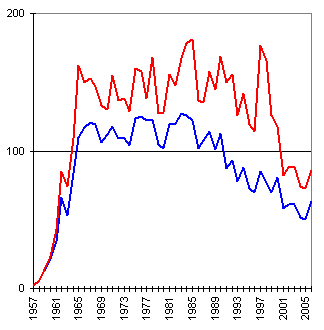 Launches to orbit and satellites orbited surged, reversing a decade-long decline, after bottoming out in 2005. And the diversity of the satellites lofted was impressive. Probes to the ends of the solar system, innovative new scientific satellites, new smaller communications and surveillance satellites, all were orbited - faster, cheaper, better than ever before. The commercial Spaceport America began construction in New Mexico. The first test launch of a commercial tourist spacecraft was undertaken in great secrecy in west Texas.
Launches to orbit and satellites orbited surged, reversing a decade-long decline, after bottoming out in 2005. And the diversity of the satellites lofted was impressive. Probes to the ends of the solar system, innovative new scientific satellites, new smaller communications and surveillance satellites, all were orbited - faster, cheaper, better than ever before. The commercial Spaceport America began construction in New Mexico. The first test launch of a commercial tourist spacecraft was undertaken in great secrecy in west Texas.
|
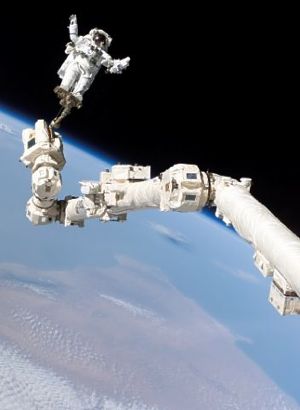 After over three years of delays, NASA seemed to finally have solved the shuttle's external tank foam shedding problem to its satisfaction. Assembly of the International Space Station was back underway. After over three years of minimal two-crew stay-alive staffing, the place was suddenly a beehive. Three shuttle missions were mounted in the last half of the year - STS-121, STS-115, STS-116. As a result, by Christmas the station was operating at the high power levels necessary for its intended use, and the permanent crew was increased from two to three. Three two-head long-term Russian/American crews served aboard the station during the year - ISS EO-12, ISS EO-13, and ISS EO-14. Aside from the shuttle missions, they were assisted or visited by other long term crew members and visitors - German astronaut Reiter, space tourist Ansari, Brazilian astronaut Pontes, and American astronaut Williams. Astronaut Statistics for the year: Twelve earthlings made their first flight in space in the last year: Ansari, Ferguson, Fossum, Fuglesang, Higginbotham, Nowak, Oefelein, Patrick, Pontes, Stefanyshyn-Piper, Williams, and Wilson. As International Space Station assembly resumed, astronauts Curbeam and Tanner racked up enough EVA time to put them in the top ten spacewalkers. Sellers, Krikalyov and Afansyev were knocked out of that ranking. No other new records in terms of cumulative flights or durations were recorded. Total space flight time: 29,875 crew-days (81.8 crew-years). Total spacewalk time: 110 crew-days. Total persons that have flown in space (including suborbital flights over 100 km altitude): 454. Persons who have flown in orbit: 451.
After over three years of delays, NASA seemed to finally have solved the shuttle's external tank foam shedding problem to its satisfaction. Assembly of the International Space Station was back underway. After over three years of minimal two-crew stay-alive staffing, the place was suddenly a beehive. Three shuttle missions were mounted in the last half of the year - STS-121, STS-115, STS-116. As a result, by Christmas the station was operating at the high power levels necessary for its intended use, and the permanent crew was increased from two to three. Three two-head long-term Russian/American crews served aboard the station during the year - ISS EO-12, ISS EO-13, and ISS EO-14. Aside from the shuttle missions, they were assisted or visited by other long term crew members and visitors - German astronaut Reiter, space tourist Ansari, Brazilian astronaut Pontes, and American astronaut Williams. Astronaut Statistics for the year: Twelve earthlings made their first flight in space in the last year: Ansari, Ferguson, Fossum, Fuglesang, Higginbotham, Nowak, Oefelein, Patrick, Pontes, Stefanyshyn-Piper, Williams, and Wilson. As International Space Station assembly resumed, astronauts Curbeam and Tanner racked up enough EVA time to put them in the top ten spacewalkers. Sellers, Krikalyov and Afansyev were knocked out of that ranking. No other new records in terms of cumulative flights or durations were recorded. Total space flight time: 29,875 crew-days (81.8 crew-years). Total spacewalk time: 110 crew-days. Total persons that have flown in space (including suborbital flights over 100 km altitude): 454. Persons who have flown in orbit: 451.
|
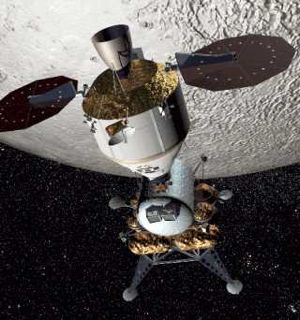 NASA selected contractors and configurations for its next generation of manned spacecraft. The Orion manned space capsule - a return to the Apollo spacecraft after a forty-year detour - was to be built by Lockheed Martin. In order to try to minimize the flight gap between the last shuttle flight and first Orion flight, NASA dropped plans for a liquid oxygen/methane propulsion system and reverted to the proven storable propellants and engines built by Aerojet for the shuttle and the Apollo CSM. Although NASA would not abandon its plans to use shuttle-derivative vehicles in order to keep its government and contractor staff intact, some measure of reality filtered in to its engine selection. NASA drooped plans to keep the misbegotten shuttle SSME in production. The Ares I earth-orbit launcher would use a new engine that took the Apollo-era J-2S as its starting point. The Ares V manned lunar booster would use the new-generation RS-68 engines that had been commercially developed for the Delta IV Medium. NASA spoke of a return to the moon, but that would certainly not be funded at the pace NASA hoped for. But human access to space by the American government seemed assured.
NASA selected contractors and configurations for its next generation of manned spacecraft. The Orion manned space capsule - a return to the Apollo spacecraft after a forty-year detour - was to be built by Lockheed Martin. In order to try to minimize the flight gap between the last shuttle flight and first Orion flight, NASA dropped plans for a liquid oxygen/methane propulsion system and reverted to the proven storable propellants and engines built by Aerojet for the shuttle and the Apollo CSM. Although NASA would not abandon its plans to use shuttle-derivative vehicles in order to keep its government and contractor staff intact, some measure of reality filtered in to its engine selection. NASA drooped plans to keep the misbegotten shuttle SSME in production. The Ares I earth-orbit launcher would use a new engine that took the Apollo-era J-2S as its starting point. The Ares V manned lunar booster would use the new-generation RS-68 engines that had been commercially developed for the Delta IV Medium. NASA spoke of a return to the moon, but that would certainly not be funded at the pace NASA hoped for. But human access to space by the American government seemed assured.
|
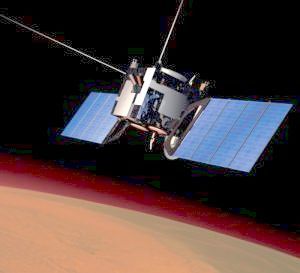 A fleet of probes explored the solar system or were en route to their destinations. The solar system fairly bustled with robotic activity. Stardust returned its capsule of comet-stuff to earth. New Horizons set off on a nine-year flight to Pluto - which had been demoted from planetary status during the year (scientists have no sense of politics - would the mission ever have been funded if it had not been the "last unsurveyed planet?"). Cassini continued its tour of the moons of Saturn, producing with each pass more detailed images of Titan's surface. Messenger continued its series of encounters with Venus, heading for an orbit around Mercury. The Mars Reconnaissance Orbiter began its mission, returning images of exquisite detail, and sighting robot landers on the surface. Venus Express arrived at that planet and began its mission, proving the clouds not to be so opaque after all. Mars Global Surveyor suddenly went out of action after ten years of service, but its images proved that there was flowing water on the Martian surface. The Mars Odyssey and Mars Express orbiters continued to operate, as did the Spirit and Opportunity MER rovers on the surface. These probes returned not only science but images of exquisite and exotic beauty.
A fleet of probes explored the solar system or were en route to their destinations. The solar system fairly bustled with robotic activity. Stardust returned its capsule of comet-stuff to earth. New Horizons set off on a nine-year flight to Pluto - which had been demoted from planetary status during the year (scientists have no sense of politics - would the mission ever have been funded if it had not been the "last unsurveyed planet?"). Cassini continued its tour of the moons of Saturn, producing with each pass more detailed images of Titan's surface. Messenger continued its series of encounters with Venus, heading for an orbit around Mercury. The Mars Reconnaissance Orbiter began its mission, returning images of exquisite detail, and sighting robot landers on the surface. Venus Express arrived at that planet and began its mission, proving the clouds not to be so opaque after all. Mars Global Surveyor suddenly went out of action after ten years of service, but its images proved that there was flowing water on the Martian surface. The Mars Odyssey and Mars Express orbiters continued to operate, as did the Spirit and Opportunity MER rovers on the surface. These probes returned not only science but images of exquisite and exotic beauty.
|
 New generations of small, highly capable military surveillance spacecraft were being orbited by not just the United States, but Japan, Israel, Germany, and France. These were cheap enough to be orbited in constellations, to ensure near-constant surveillance, in all weather. IGS-3A, Tacsat-2, Ofeq 3, Helios-2, and perhaps the mysterious USA 193 - all were revolutionizing military use of satellites in tactical operations - for those nations that could loft them.
New generations of small, highly capable military surveillance spacecraft were being orbited by not just the United States, but Japan, Israel, Germany, and France. These were cheap enough to be orbited in constellations, to ensure near-constant surveillance, in all weather. IGS-3A, Tacsat-2, Ofeq 3, Helios-2, and perhaps the mysterious USA 193 - all were revolutionizing military use of satellites in tactical operations - for those nations that could loft them.
|
 China's space program, on the other hand, fizzled. Development of the new CZ-5 launch vehicle series was behind schedule. Its new-generation DFH-4 communications satellite finally made it to orbit, only for its antennae to fail to deploy - ruining plans for Beijing 2008 Olympics coverage. The semi-hilarious FSW seed satellite finally orbited - hopefully the only test of a project so obviously driven by internal state politics. The next flight of the Shenzhou manned spacecraft was deferred until after the 2008 Olympics. A model was shown of the latest design iteration of the planned 20-tonne Chinese Space Laboratory, which revealed it to look much like the early Soviet Salyut.
China's space program, on the other hand, fizzled. Development of the new CZ-5 launch vehicle series was behind schedule. Its new-generation DFH-4 communications satellite finally made it to orbit, only for its antennae to fail to deploy - ruining plans for Beijing 2008 Olympics coverage. The semi-hilarious FSW seed satellite finally orbited - hopefully the only test of a project so obviously driven by internal state politics. The next flight of the Shenzhou manned spacecraft was deferred until after the 2008 Olympics. A model was shown of the latest design iteration of the planned 20-tonne Chinese Space Laboratory, which revealed it to look much like the early Soviet Salyut.
|
 After an attempt to surge military space in previous years, Russian space launches sagged to their lowest level since 1999. The new Bulava missile failed twice in two flight tests. The Russian space industry tinkered with the design of the Kliper spacecraft replacement, and dusted off old plans for the exploration of the Moon and Mars to try to goad the government into action against the "American challenge", but funds were evidently not forthcoming. Minimum launches were made to keep military capabilities ticking over, and a concerted effort to get the Glonass navigation satellite constellation in working order continued. India's only launch of the year ended in a failure of the GSLV booster - not good for attempts to commercially market the vehicle.
After an attempt to surge military space in previous years, Russian space launches sagged to their lowest level since 1999. The new Bulava missile failed twice in two flight tests. The Russian space industry tinkered with the design of the Kliper spacecraft replacement, and dusted off old plans for the exploration of the Moon and Mars to try to goad the government into action against the "American challenge", but funds were evidently not forthcoming. Minimum launches were made to keep military capabilities ticking over, and a concerted effort to get the Glonass navigation satellite constellation in working order continued. India's only launch of the year ended in a failure of the GSLV booster - not good for attempts to commercially market the vehicle.
|
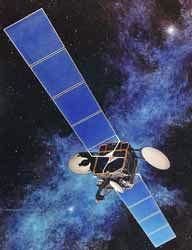 30% of the launches were of communications satellites, with the market dominated by the circa-4 tonne buses offered by EADS Astrium, SS/Loral, Alcatel Alenia Space, and Lockheed Martin. A few of the new light buses being marketed by other manufacturers were orbited. For the heavies, Ariane 5 EC-A was the launcher of choice for six, the Proton 8K82M and Zenit-3SL for four each, and the Atlas V was used for a single launch. The industry felt it had reached a kind of stability after the shakeout of the last few years, and projections were that traffic would continue at about this level or increase slightly over the next few years.
30% of the launches were of communications satellites, with the market dominated by the circa-4 tonne buses offered by EADS Astrium, SS/Loral, Alcatel Alenia Space, and Lockheed Martin. A few of the new light buses being marketed by other manufacturers were orbited. For the heavies, Ariane 5 EC-A was the launcher of choice for six, the Proton 8K82M and Zenit-3SL for four each, and the Atlas V was used for a single launch. The industry felt it had reached a kind of stability after the shakeout of the last few years, and projections were that traffic would continue at about this level or increase slightly over the next few years.
|
 The Atlas V and Delta IV Medium became essentially state-run enterprises, with assembly being made at a common factory. Commercial sales for both vehicles failed to materialize and NASA refused to use them to launch its Orion manned capsule. The Air Force will keep both in production to ensure continued military access to space even if one or the other is grounded…
The Atlas V and Delta IV Medium became essentially state-run enterprises, with assembly being made at a common factory. Commercial sales for both vehicles failed to materialize and NASA refused to use them to launch its Orion manned capsule. The Air Force will keep both in production to ensure continued military access to space even if one or the other is grounded…
|
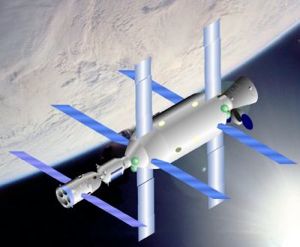 The brightest spot of the year was the resurgence of privately-funded manned spaceflight. Virgin Galactic began construction of a spaceport west of Roswell for the SpaceShipTwo suborbital tourist spacecraft. South of Roswell, Blue Origin's New Shepard actually began flight tests. NASA provided seed money for the Falcon 9 booster, the Dragon re-entry vehicle, and the Kistler K-1 - all means for commercial private access to orbit. Bigelow flew the Genesis Pathfinder, a prototype for his Sunchaser and Nautilus BA-330 orbiting hotels, and promised continued personal investment until a facility was available in orbit - on the premise of "build it and they will come". There were other less likely contenders, but would the New Space Tourism be the joker that finally gets human space exploration under way? The Falcon I commercial vehicle failed on its first launch - nobody said it would be easy…
The brightest spot of the year was the resurgence of privately-funded manned spaceflight. Virgin Galactic began construction of a spaceport west of Roswell for the SpaceShipTwo suborbital tourist spacecraft. South of Roswell, Blue Origin's New Shepard actually began flight tests. NASA provided seed money for the Falcon 9 booster, the Dragon re-entry vehicle, and the Kistler K-1 - all means for commercial private access to orbit. Bigelow flew the Genesis Pathfinder, a prototype for his Sunchaser and Nautilus BA-330 orbiting hotels, and promised continued personal investment until a facility was available in orbit - on the premise of "build it and they will come". There were other less likely contenders, but would the New Space Tourism be the joker that finally gets human space exploration under way? The Falcon I commercial vehicle failed on its first launch - nobody said it would be easy…
|
Back to top of page
Home - Search - Browse - Alphabetic Index: 0- 1- 2- 3- 4- 5- 6- 7- 8- 9
A- B- C- D- E- F- G- H- I- J- K- L- M- N- O- P- Q- R- S- T- U- V- W- X- Y- Z
© 1997-2019 Mark Wade - Contact
© / Conditions for Use